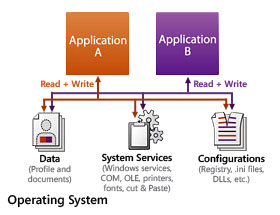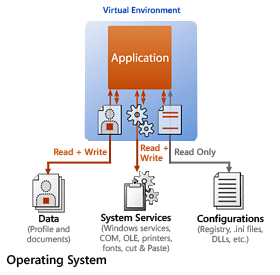Introduction
This article introduces Microsoft Application Virtualization, formerly known as Microsoft SoftGrid Application Virtualization, its benefits, features, and functionalities of Application Virtualization that help you to support application deployment and management in your organization.
What is Application Virtualization?
Application Virtualization provides a method to deploy and manage applications on client computers without needing to install the applications locally on each client computer.
To understand it more, let’s say you perform a traditional application installation on a client computer, the application has read/write access to various operating system locations; Windows registry; system services, printers; and user profile information. However, when a virtualized application is deployed to a client computer, a virtual environment that contains all the operating system and application components is created. Now if an operating system resource is not a part of the defined virtual environment, the virtualized application has read-only access to that operating system resource installed on the client computer.
What is Microsoft Application Virtualization (App-V)?
Application virtualization is at the nucleus of Microsoft Application Virtualization (App-V) which decouples applications from the operating system and transforms regular applications into AAS “Applications As Services” by enabling them to run as network services. Application virtualization can be layered on top of other virtualization technologies—network, storage, machine—to create a fully virtual IT environment where computing resources can be dynamically allocated in real-time based on real-time needs.
| Standard Operating System Environment | The Virtual Application Environment |
 |  |
In standard OS environments, applications install their settings onto the host operating system, hard-coding the entire system to fit that application's needs. Other applications' settings can be overwritten, possibly causing them to malfunction or break.
| With application virtualization, each application brings down its own set of configurations on-demand, and executes in a way so that only it sees its own settings.
|
Why Application Virtualization?
Application Virtualization differs from other forms of virtualization and remote access by not requiring a large investment in hardware, personnel, or core infrastructure. By inducing an Application Virtualization environment, you can reduce the TCO (Total cost of ownership) of organizational processes related to application compatibility testing, application updates, user downtime, and help-desk support.
Moreover, traditional application deployment processes involve various challenges, such as application compatibility issues, coexistence issues when combining application versions, and maintenance of application updates.
Since Application Virtualization provides a method of deploying and maintaining applications from a central location without requiring a local installation of the application on the client computer, you can easily respond to changing organizational requirements, such as a change in application permissions or the deployment of a software update. Application Virtualization creates a virtual environment in which the virtualized application runs. This provides many benefits, such as reduced application compatibility issues and the ability to run multiple versions of an application on a client computer. Application Virtualization also helps to manage license compliance by controlling the number of users permitted to access an application. You can use Application Virtualization features to simplify application management when you deploy, update, or terminate software applications to client computers.
Virtual Application Management Life Cycle
Application Virtualization makes our world easy by simplifying and eliminating many of the time-consuming and manual tasks involved in the application management life cycle. The various stages of the application management life cycle are application packaging, deployment, updates, support, and termination.
 | Application Packaging
| Application packaging is the process of preparing applications for deployment on client computers. You can create an application package, also called a sequenced application, by using the Application Virtualization Sequencer. You can use the Application Virtualization Sequencer to monitor and record the application installation and the files that are used to run the application. All required files are then packaged into a virtualized self-contained environment to be deployed on Application Virtualization clients. |
 | Application Deployment
| Application deployment is the process of deploying applications to client computers. You can configure the Application Virtualization server to stream authorized application packages to client computers, thereby eliminating the need to install the application locally on each client computer. This helps to avoid application compatibility issues with the operating system and other locally installed applications, but allows the virtualized application to use local resources. |
 | Application Update
| Application update is the process of applying revisions and updates to the application by using service packs or software updates. Application Virtualization allows you to easily update a package that is deployed throughout the network. The updated application is sequenced by using the Application Virtualization Sequencer and is published on the Application Virtualization server. A client computer installed with the Application Virtualization client receives the updated files the next time the application is launched. |
 | Application Support
| Application support is the process of maintaining and troubleshooting applications. Maintaining an entire applications library can be difficult because issues may arise due to application conflicts and deletion of important files by users. Application Virtualization reduces application conflicts because each application runs in an Application Virtualization environment. In addition, virtualization-enabled applications are not vulnerable to inadvertent or intentional deletion of files by users. This helps reduce the number of help-desk calls you receive. |

| Application Termination
| Application termination is the process of replacing or retiring applications, and removing them from the client environment. Typically, you need to uninstall the application on every client computer. This may isolate some application files and registry settings, and may cause application conflicts later. Application Virtualization helps you to centrally deactivate or remove the retired application from all client computers in the Application Virtualization environment. |
History
- 8th April, 2009: Initial post
 General
General  News
News  Suggestion
Suggestion  Question
Question  Bug
Bug  Answer
Answer  Joke
Joke  Praise
Praise  Rant
Rant  Admin
Admin 








